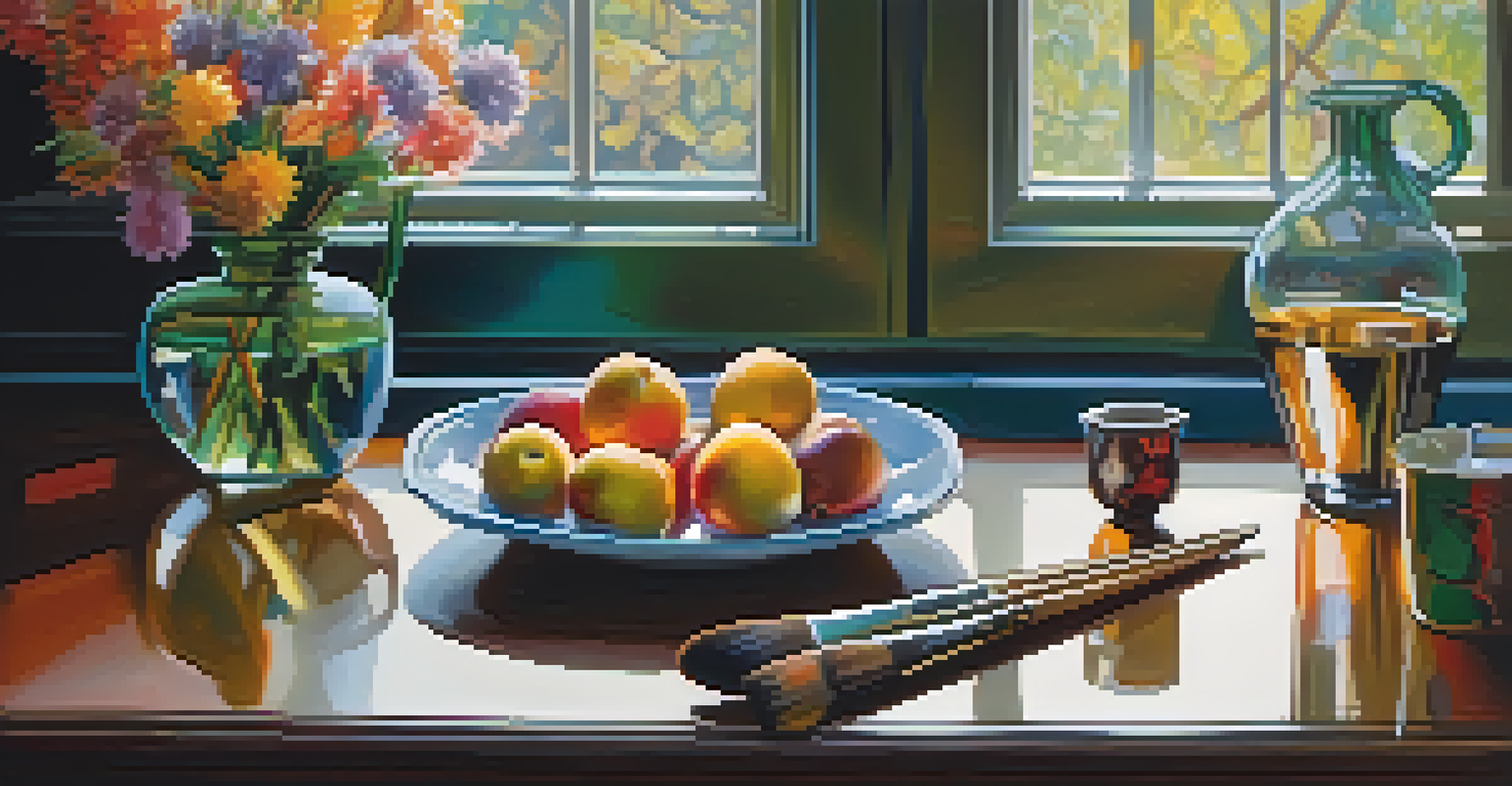Art as a Reflection of Time: Understanding Historical Context

The Interplay Between Art and Society
Art does not exist in a vacuum; it thrives within the context of societal dynamics. Artists are often influenced by the events, struggles, and triumphs happening around them. For instance, during times of war, art may shift toward themes of conflict and resilience, capturing the emotional landscape of the people.
Art is the most beautiful of all lies.
Consider the impact of the Renaissance—a period marked by a renewed interest in science, philosophy, and humanism. Artists like Leonardo da Vinci and Michelangelo created works that celebrated human potential, reflecting the cultural evolution of their time. Their masterpieces serve as visual diaries, chronicling the values and aspirations of society.
Through art, we gain insight into historical moments and the collective psyche of people. This relationship not only enhances our understanding of past cultures but also deepens our appreciation for the artistic expressions that emerge from different eras.
Art Movements and Historical Events
Art movements often arise as direct responses to historical events, shaping and being shaped by the world around them. For example, the Impressionist movement emerged in France during the late 19th century, a time of rapid industrialization and urbanization. Artists like Monet and Degas focused on capturing the fleeting moments of modern life, reflecting the changes in society.

Similarly, the Dada movement was born out of the chaos of World War I, challenging traditional values and embracing absurdity. This art form questioned the very fabric of reality, mirroring the disillusionment felt by many during that tumultuous time. Dada artists turned to irony and humor as a means of coping with societal upheaval.
Art Reflects Societal Dynamics
Art thrives within societal contexts, capturing the emotions and experiences of people during significant historical moments.
These movements illustrate how art can serve as a barometer for cultural shifts, providing commentary on the prevailing sentiments of the time. By studying these connections, we gain a richer understanding of how history and creativity intertwine.
The Role of Politics in Artistic Expression
Politics has always played a crucial role in shaping art, influencing not only what is created but also how it is perceived. Throughout history, artists have used their work as a form of protest or propaganda, reflecting the political climate of their time. For instance, Picasso’s 'Guernica' powerfully depicts the horrors of war, serving as a political statement against the Spanish Civil War.
Every artist dips his brush in his own soul, and paints his own nature into his pictures.
In more recent times, street art has emerged as a popular medium for political expression. Artists like Banksy use public spaces to communicate messages about social justice, inequality, and government accountability. These pieces often provoke thought and inspire dialogue, demonstrating the enduring power of art as a tool for change.
By examining political themes in art, we can better understand the struggles and aspirations of different eras. This connection highlights the vital role that artists play in shaping public discourse and challenging societal norms.
Cultural Identity and Artistic Heritage
Art is a powerful medium for expressing cultural identity, encapsulating the traditions, beliefs, and values of a community. Each piece often tells a story, revealing the unique experiences of its creators. For example, Indigenous art often incorporates symbols and narratives that are deeply rooted in the cultural heritage of the people.
As cultures evolve and interact, their art forms also transform, creating a rich tapestry of influences. The fusion of styles can be seen in movements like Afro-Brazilian art, which blends African traditions with European influences. This cultural exchange enriches the artistic landscape, making it a dynamic reflection of society.
Political Themes Shape Art
Throughout history, artists have used their work to comment on political climates, influencing public discourse and societal change.
Understanding the relationship between art and cultural identity allows us to appreciate the diverse narratives that shape our world. It also fosters a sense of connection and respect among different communities, highlighting the universal nature of artistic expression.
Technology's Impact on Artistic Expression
Advancements in technology have continually transformed the way art is created and experienced. From the invention of the printing press to the rise of digital art, each technological leap has opened new avenues for creative expression. For example, the advent of photography challenged traditional painting, leading artists to explore new styles and subjects.
Today, digital platforms allow artists to reach global audiences, sharing their work instantly across the internet. This democratization of art means that anyone with a smartphone can become a creator, reshaping how we define artistic talent. Social media has also created new forms of engagement, enabling artists to connect with their audience in real-time.
As technology continues to evolve, so too will the ways in which we create and appreciate art. This ongoing dialogue between art and technology reflects the changing nature of society, inviting us to explore new possibilities together.
The Legacy of Art Through Time
The legacy of art is a testament to its enduring power and significance across generations. Great works often transcend their initial context, continuing to inspire and provoke thought long after their creation. Take, for example, Van Gogh’s 'Starry Night,' which, despite being painted over a century ago, still resonates with viewers today.
Art also serves as a historical record, capturing the essence of its time and providing insights into the human experience. Museums and galleries curate collections that tell the stories of different periods, allowing us to engage with the past in meaningful ways. Each piece becomes a window into the lives and emotions of those who came before us.
Cultural Identity Through Art
Art serves as a powerful medium for expressing cultural identity, revealing the unique stories and experiences of different communities.
By preserving and celebrating art, we ensure that future generations can learn from our history. The legacy of art not only enriches our understanding of the past but also inspires us to dream, create, and contribute to the ongoing narrative of humanity.
Reflecting on Art's Role in Our Lives
As we explore the relationship between art and historical context, it's essential to consider the role art plays in our own lives. Art enriches our daily experiences, providing a source of inspiration, comfort, and connection. Whether it's through music, visual arts, or literature, we are constantly engaging with creative expressions that resonate with our emotions.
Additionally, art encourages us to reflect on our values and beliefs, prompting us to question societal norms and envision new possibilities. Engaging with art can foster empathy, as we immerse ourselves in diverse perspectives and narratives. This engagement highlights the importance of supporting artists and cultural initiatives.

Ultimately, recognizing art as a reflection of time deepens our appreciation for both the art itself and the historical moments it embodies. By understanding this connection, we can cultivate a richer, more inclusive dialogue about the experiences that shape our world.